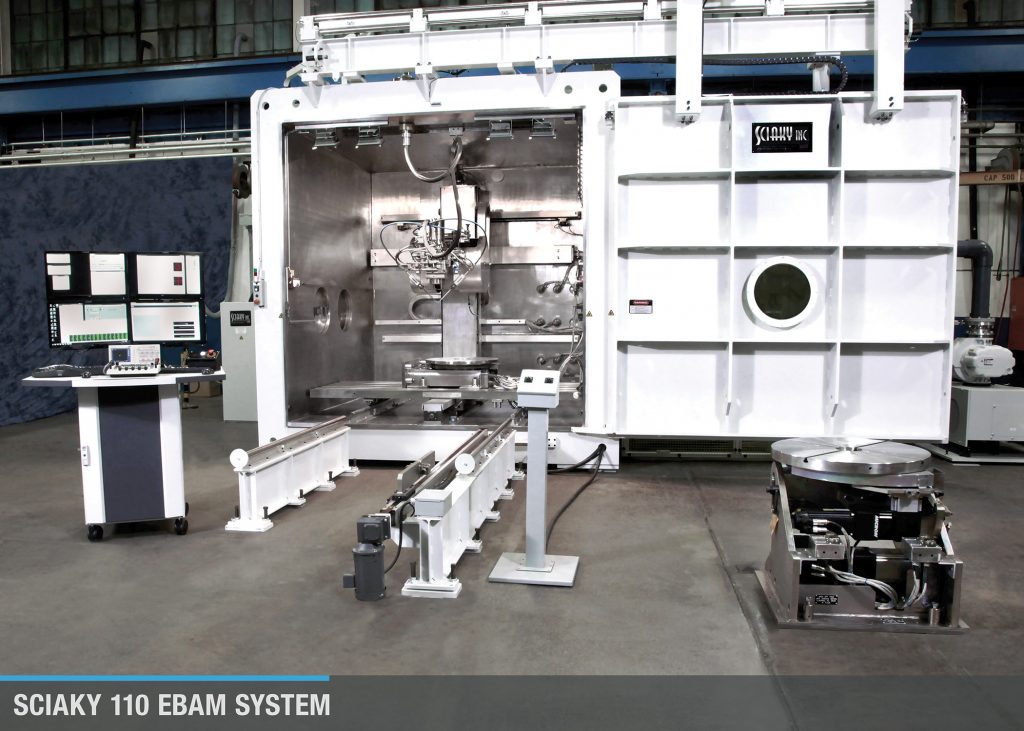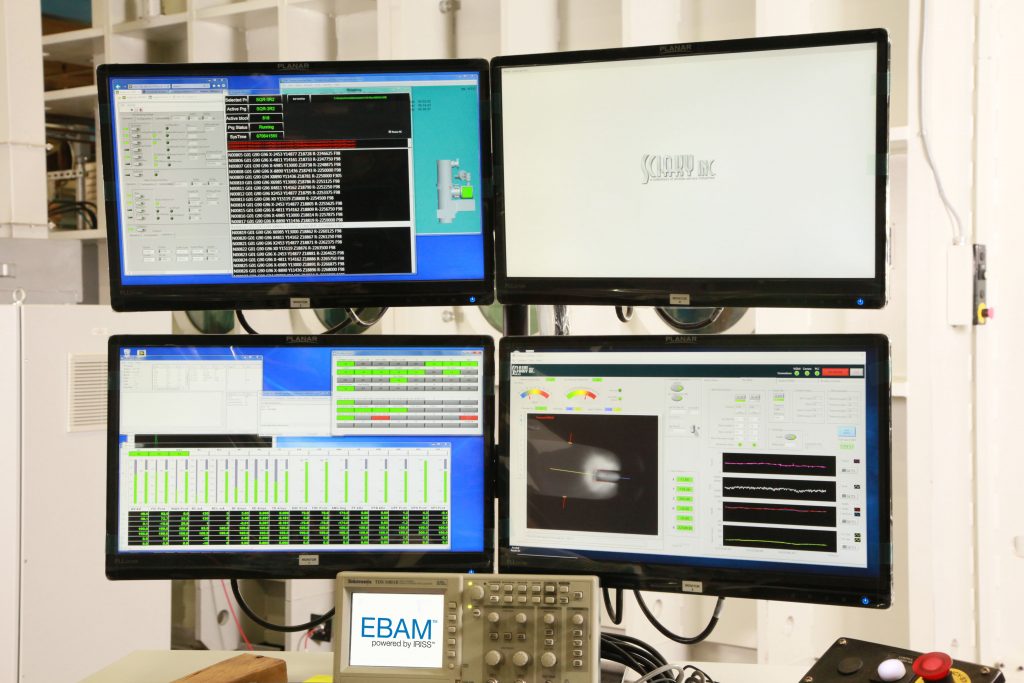Established in 1939, Sciaky draws upon industry-leading electron beam welding expertise that long precedes additive manufacturing. As such, when manufacturing was looking for new, economical solutions for producing titanium parts, the company was quick to adapt.
Electron Beam Additive Manufacturing (EBAM®) technology was first introduced by Sciaky as a service for its for its customers in nuclear, aerospace and defense sectors. Then, as interest picked up, Sciaky launched its first EBAM® turnkey system, which has been on the market since 2014. EBAM® equipment and services now account for around 75% of the company’s overall revenue.
Industry-wide, metal additive manufacturing continues to evolve, welcoming new technologies and competitors. For customers, it has become more challenging to identify the best process for their purpose. In hardware, a great deal of research is also being undertaken to optimize metal AM for reliable, repeatable results. With EBAM®, Sciaky is addressing these challenges in a number of ways.
In conversation with John O’Hara and Kenn Lachenberg, 3D Printing Industry learns more about the unique aspects of Sciaky EBAM® technology, and the company’s IRISS closed-loop control capable of correcting the process on the fly. O’Hara is Director of Global Sales at Sciaky, and has been with the company for over six years. Lachenberg, on the other hand, has spent three decades working for Sciaky, through manufacturing, engineering, applications and sales, to Director of Operations.

Large scale metal additive
Sciaky EBAM® is a large scale process. In terms of mass, EBAM® has produced a titanium aircraft wing spar that stretched 12 feet in length (3.7m), a titanium bulkhead with an 8½-foot diameter (2.6m), and a huge titanium prototype (for the aerospace industry) that weighed more than 3,000 pounds (1,360kg), which took 120 hours to build.
The company’s standard machines range in build size from the EBAM® 300, which is 300” x 108” x 132” (7.6m x 2.7m x 3.4m), to the EBAM® 110, which is 110” x 110” x 110” (2.8m x 2.8m x 2.8m). In addition to size, the company also claims some of the highest deposition rates in the industry. O’Hara adds, “We really put out there that this is a unique capability.”
“There are other wire-fed processes and other high deposition rate processes. But we’ve really come to be known as the one technology that’s fairly unique in really large parts, at exceptionally high deposition rates.”
At the development stage, Sciaky EBAM® deposition rate was quoted at 15lbs/hr (6.8kg/hr). “That’s when we were refining the technology,” says Lachenberg, “That was not at all a limitation to the equipment and the capabilities of the system, we are only using a small portion of the headroom of the the equipment to produce 15lbs./hr.” Expanding the deposition rate even further, the company is now capable of an EBAM® deposition rate of 25lbs/hr (11.4kg/hr) when producing a part in the shortest time possible.
“But that limitation,” Lachenberg adds, “is not really even a limitation, either. We have plenty of headroom and capability to even go at higher deposition rates, we just haven’t ventured into much above the 25 pounds per hour.”
When it comes to size O’Hara adds, “From our experience with welding systems, the welding systems may be custom built. So we are not afraid at all to build a chamber that is custom for a particular end user, in fact, one of the systems we have on contract that we’re assembling today is exactly that. It’s a custom size somewhere between the 110 and the 150.”

Qualification for land, sea, air and space
Many of the projects Sciaky works on are classified, due to the nature of the industry they are made for, i.e. aerospace and defense. Airbus, Northrop Grumman and Lockheed Martin are all engaging partners with the company. In these projects, the company also applies what it calls a “dual process capability” combining EBAM® with EB welding. To date, with its varied customer base, Sciaky believes to be “the only large-scale metal AM solution provider with applications in Land, Sea, Air and Space.”
One of the key features that has earned Sciaky’s EBAM® technology this position across all modes of transport, is the purity of its process. As an example, Lachenberg explains, “Both arc or a laser welding processes, need significant shielding gas for dealing with refractory materials. However, this environment will still probably have in the area of 300 to 500 ppm contaminants,”
“With the vacuum environment that we utilize within our machines, the component is exposed to only around 0.1 ppm contaminants. So, the material properties [of EBAM® parts] are more in line with a vacuum metal melting process to produce quality much like a forging.”
“A lot of the other additive processes,” O’Hara adds, “many of them fantastic processes, were really processes that were invented, and then the production machinery was built around them.
“EBAM® is built on an already established platform, with hundreds of them deployed worldwide. The production readiness of the equipment itself really is very robust.”
Adaptive IRISS® control and custom alloys
IRISS® is the process control system inside Sciaky’s EBAM® machines. It stands for Interlayer Realtime Imaging & Sensing System. Though many metal additive manufacturing systems on the market incorporate similar systems for control, e.g. recording and storing footage of the build, the key feature of Sciaky’s IRISS® platform is its real-time adaptability.
“It’s the way that we dynamically monitor and change process parameters as we build up a geometry to maintain the microstructure chemistry and mechanical properties,” explains Lachenberg. “It also incorporates a special pattern generated with the beam.”
Rather than a single beam, as in some selective laser melting (SLM) machines, the Sciaky electron beam can generate a customized raster pattern, “like on old TV sets,” Lachenberg adds. “The orientation of the pattern makes for a very unique energy distribution in the melt pool, as well as upstream and downstream of the melt pool, so with this, it can provide very tailored microstructures as well.”
The way O’Hara describes the function of IRISS®, is that “we target every gram of metal to experience the same transition from solid, to melting, and through the solidification process.”
By further experimenting with the electron beam pattern, in the future Sciaky aims to be able to tune the properties of additive manufactured parts in a way never done before, and to work producing parts with so-called “unweldable metal alloys.”
“And this also falls in the case with multiple wire feed capability,” comments Lachenberg, “where you could then customize your alloys with let’s say, one wire feed metal from one group of alloy mixed with another wire feed from another material. Since this could be done at a precisely controlled programmed rate, you can effectively create your own unique alloy mixture with this approach.”

Sciaky among the competition
Sciaky, in many ways, is the go-to when it comes to large scale metal additive manufacturing and high deposition rates. As O’Hara points out, “For this subset of customers who are interested in that, it’s really pretty easy to find us.” It’s also clear that the company places emphasis on process reliability and its heritage. As asserted by the company, “We provide very large metal 3D printing systems, but trust is the biggest thing we sell.”
O’Hara adds, “The technology is really unique. In comparison to the other metal additive processes out there, we just really don’t consider any of them to exist in the same space that we occupy.”
Lachenberg concludes, “EBAM offers triple process capability in a single machine that provides additive manufacturing, cladding and EB welding, which sets us apart from all other AM systems on the market today. We are one of the only companies that employ AM systems that build applications for land, sea, air and space. And, in many respects, EBAM® is a burgeoning technology that adheres to the same traditional manufacturing process requirements.”
For more information on Sciaky, visit www.sciaky.com or call an EBAM® expert at 877-450-2518 to inquire about a project or quote. Sciaky is located in Chicago, IL.
Sciaky’s project with Lockheed Martin has been nominated for Aerospace Application of the Year in the 2019 3D Printing Industry Awards. Vote now to decide this year’s winners.
For more of the latest additive manufacturing news and exclusive interviews subscribe to the 3D Printing Industry newsletter, follow us on Twitter and like us on Facebook. Seeking jobs in engineering? Make your profile on 3D Printing Jobs, or advertise to find experts in your area.
Featured image shows a titanium gimbal made with Sciaky’s EBAM® process, which weighs 80 pounds. Photo via Sciaky Inc.



